|
|
|
Sort Order |
|
|
|
Items / Page
|
|
|
|
|
|
|
| Srl | Item |
| 1 |
ID:
147512


|
|
|
|
|
| Summary/Abstract |
Israel’s security doctrine has traditionally distinguished between routine threats (low-intensity attacks by state armies or non-state organisations) and fundamental threats (high-intensity offensives by state armies). It has paid much less attention to the middle ground: the medium-intensity threat. That threat has grown in the wake of changes to the priorities of some Arab states; reductions in the military capabilities of others; and the emergence of non-state organisations that have acquired some state capabilities and that have successfully combined guerrilla and terror tactics (irregular warfare) with more conventional practices (regular warfare). Indeed, medium-intensity warfare is now the strategic focus of some of Israel’s active enemies. The country’s security doctrine must address this grey area, first by defining it, and then by identifying the optimal strategies and tactics that will be required to combat it.
|
|
|
|
|
|
|
|
|
|
|
|
|
|
|
|
| 2 |
ID:
190866


|
|
|
|
|
| Summary/Abstract |
The aim of this article is to add an air power perspective to the innovation field, with emphasis on the development of jet fighters. Contemporary theory has not adequately addressed air power-related significant innovation, a shortcoming this article addresses. Using in-depth qualitive research methodology with eight diverse case-studies in the Cold War period, we show that innovation of jet fighters was typically initiated in response to hegemonic tensions, immediate threats and organsational factors such as civil–military relations, bureaucratic politics, and air force innovation culture. Moreover, through a comparative analysis we argue that significant and successful air power innovation is achieved through proficiency and knowledge gained by constant learning of air power theory and bottom-up innovation mechanisms. Looking forward, this study may be significant for assisting military professionals in making better-informed decisions about the use of fifth-generation air power by implementing past lessons learned into contemporary theory and future plans.
|
|
|
|
|
|
|
|
|
|
|
|
|
|
|
|
| 3 |
ID:
111221


|
|
|
|
|
| Publication |
2012.
|
| Summary/Abstract |
Moshe Dayan was Israel's most influential and original soldier. He shaped the Israeli Defense Forces' (IDF's) culture first as chief of staff in the 1956 campaign and later as defense minister during both the conventional wars of 1967 and 1973. However, before, between, and during these large conventional engagements, the IDF conducted 'Current Security Operations,' small military operations against Arab insurgency. After 1967, the IDF faced the challenge of controlling the population in West Bank and Gaza. Moshe Dayan was instrumental in setting the policy toward the population from the foundation of the IDF to the crucial time after 1967; his ideas on and practices in counterinsurgency form a tradition in themselves. Dayan's attitude toward the population developed first under the mentorship years of Charles Orde Wingate, the British Army, and the Palmach (the Jewish strike units) during the British mandate in Palestine; then the reprisals period in the early 1950s, subsequently as a reporter and an observer in Vietnam in 1966, and finally in the 'open bridges policy,' developed by Dayan immediately after the Six-Day War.
|
|
|
|
|
|
|
|
|
|
|
|
|
|
|
|
| 4 |
ID:
193160


|
|
|
|
|
| Summary/Abstract |
This paper to uncovers how leaders practice emergent strategy as a core strategic philosophy. The article uses the case of general and statesman Moshe Dayan as a principal case study to uncover leadership and management practices of emergent strategy. Following a discussion on the emergent versus deliberate strategy schools, I show why Moshe Dayan as a leader can be considered as an archetype of the emergent approach worth studying. I then present six leadership principles that enabled him to practice the emergent approach. The article concludes with discussion of the limitations and value of the emergent approach for leaders today.
|
|
|
|
|
|
|
|
|
|
|
|
|
|
|
|
| 5 |
ID:
160945
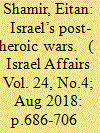

|
|
|
|
|
| Summary/Abstract |
This article examines the role of American military influence on Israel’s transition to post-heroic warfare. The main factors identified in the existing literature that have been identified to explain Israel’s transition to post-heroic warfare had to do with the changes in Israel’s strategic environment, changes in society and development of new military technology. This article sheds light on an intervening factor that further enables and shapes the transition to post-heroic war; the American military influence over the Israel Defence Forces. The strategic uncertainty and lack of professional direction encouraged Israel’s military establishment to turn to American military ideas. The US military is perceived by the IDF as a leading professional institution that is dealing with similar challenges and operating under similar constraints.
|
|
|
|
|
|
|
|
|
|
|
|
|
|
|
|
| 6 |
ID:
099703
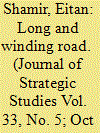

|
|
|
|
|
| Publication |
2010.
|
| Summary/Abstract |
The purpose of the current paper is to examine the adoption and adaptation process of mission command (Auftragstaktik) in the US Army. This concept, developed by the Prussians, denotes a decentralized command approach wherein superiors dictate their intent and allow subordinates to formulate their operational plans independently and change it according to the emerging situation. The paper examines the US command approach prior to the adoption of mission command. It argues that it was heavily influenced by corporate management practices which inherently contradict mission command approach. It continues and investigates how the US Army endeavored to emulate the approach in its doctrine and in major operations.
|
|
|
|
|
|
|
|
|
|
|
|
|
|
|
|
| 7 |
ID:
105381
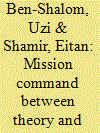

|
|
|
| 8 |
ID:
128303
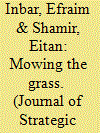

|
|
|
|
|
| Publication |
2014.
|
| Summary/Abstract |
'Mowing the Grass', Israel's strategy in the twenty-first century against hostile non-state groups, reflects the assumption that Israel finds itself in a protracted intractable conflict. The use of force in such a conflict is not intended to attain impossible political goals, but a strategy of attrition designed primarily to debilitate the enemy capabilities. Only after showing much restraint in its military responses does Israel act forcefully to destroy the capabilities of its foes, hoping that occasional large-scale operations also have a temporary deterrent effect in order to create periods of quiet along its borders. The Israeli approach is substantively different from the current Western strategic thinking on dealing with non-state military challenges.
|
|
|
|
|
|
|
|
|
|
|
|
|
|
|
|
| 9 |
ID:
151810
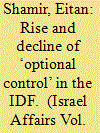

|
|
|
|
|
| Summary/Abstract |
Mission command is a command philosophy that denotes decentralized leadership; it is a philosophy of command that requires and facilitates initiative in all levels of command and encourages subordinates to exploit opportunities by empowering them to demonstrate initiative and exercise personal judgement. In its first decades of existence, military analysts portrayed the Israeli command system as such and termed it ‘optional control’. The primary objective of this article is to explore the rise and decline of ‘optional control’ in the IDF. The first part of the article follows the development of optional control in the IDF’s first decades of existence until the 1970s. The second part of the paper will describe its decline through the analysis of command in recent IDF military campaigns. The last part is analysis; explanation for the decline in mission command is attributed to four major factors: the changes in Israel’s society and thereof in civil‒military relations; the changes in character of military operations; the lack of appropriate military education; and the role and impact of new technologies on the IDF. The combined effect of these factors impedes the ongoing efforts of the IDF to re-establish mission command as its preferred command philosophy.
|
|
|
|
|
|
|
|
|
|
|
|
|
|
|
|
| 10 |
ID:
157892


|
|
|
|
|
| Summary/Abstract |
The special operations forces (SOF) of the industrial democracies have suddenly and rapidly grown in numbers and resources during the past decades. Most explanations for this growth focus on factors external to the armed forces. We argue that the enlargement of SOF is also the result of internal organizational dynamics. First, we compare SOF to other units and military appendages that have grown over the past 30 years in order to delineate what is unique to their development and the special adaptive potential they bring to the armed forces: generalized specialization, boundary spanning roles, and enlargement of military autonomy. Second, we analyze the actions of internal military entrepreneurs and their organizational mentors to show how they use this adaptive potential to “sell” the use of SOF to key policy-makers and decision-makers.
|
|
|
|
|
|
|
|
|
|
|
|
|
|
|
|
| 11 |
ID:
148470
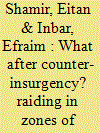

|
|
|
|
|
| Summary/Abstract |
This article argues that the option of a military raid is becoming more relevant in the contemporary strategic environment. Two developments lead to this conclusion: the increase in the number of so-called failed states and subsequently ungoverned areas; and the western inadequate response in the attempts to create zones of stability with clear strategic addresses. The efforts for statebuilding in Iraq and Afghanistan have failed, and the US and its allies have realized that foreign interventions, even after the commitment of much treasure and blood, are ineffective. This means that the West must adapt its strategic thinking to the new developments and devise ways to deal effectively with the situation. This article explores the concept of strategic raid and elaborates on its theoretical underpinnings. The raids discussed here are military operations conducted in order to weaken and/or deter a non-state actor, at least temporarily. In the absence of diplomatic and economic leverage, the aim is limiting the actor's ability to harm others. The use of force is designed to degrade the military capabilities of the non-state adversary and to influence its resolve. Subsequently, it discusses a few historical examples of raiding strategy and then analyses two contemporary cases, Israel and the United States, in order to demonstrate the utility of raids today. Finally, the relevance of raiding strategy for other states in the contemporary strategic environment is discussed.
|
|
|
|
|
|
|
|
|
|
|
|
|
|
|
|
|
|
|
|
|